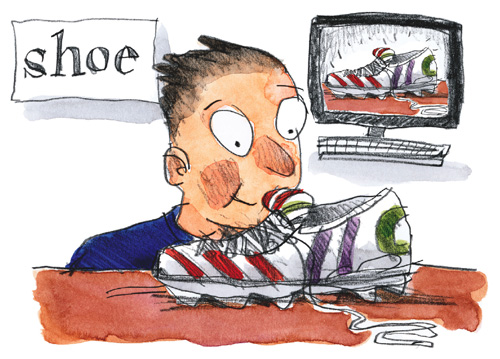Brains Like To Keep It Real
By Catherine Clabby
Text and images may be king on the Internet, but people in a position to buy seem to prefer the real thing
Text and images may be king on the Internet, but people in a position to buy seem to prefer the real thing

DOI: 10.1511/2010.87.467
In this age of fierce competition between Internet marketing and traditional retail, merchants want to know: Which approach stirs potential customers most?
Experiments by neuroeconomist Antonio Rangel and his colleagues suggest that the old pop song chorus—“Ain’t nothing like the real thing, baby”—might have it right.
The findings could be relevant to more than shopping, however. They may give insight into the ways our brains assign value in the computational activity that is human choice.

Illustration by Tom Dunne.
“Whether the stimuli are physically present or not really affects the values you assign and the choices you make,” says Rangel, a California Institute of Technology researcher who published the research results with his colleagues in the American Economic Review in September.
Rangel, an economist-turned-neuroscientist, is one of those people eager to find the biological basis for human behavior, including choice making. He and many others have concluded that choices are made based on the values people assign to the options they encounter.
In a series of experiments, his group set out to learn how people assign values to the same goods presented differently: as text on a computer screen, as a high-quality photograph on the same screen or as the thing itself.
They randomly presented more than 50 hungry Caltech students with snack foods such as candy bars, potato chips and other sweet and salty snacks, one by one, in three different conditions: a text condition where the food’s name was written; a high-resolution picture of the food; or the actual snack in a tray. The students were asked to assign values to each of the foods.
On average, there was no difference in the subjects’ willingness to pay for the foods between the text and picture conditions, but subjects were willing to pay, on average, 50 percent more for items that were physically present. Importantly, these were real decisions: Subjects purchased those items at the stated price.
Concerned that noses rather than brains were guiding these judgments, the authors repeated the experiment with something other than food. They asked their subjects to rate Caltech paraphernalia: key chains, pens and baseball caps. The students still were willing to pay about 50 percent more for the goods in the real condition, with no difference between text and picture. “We were shocked when it replicated with all of our goods, like the trinkets,” Rangel says. “Somehow the brain knows it is present, and computes the value of stimuli differently when this is the case.”
To gain more insight about the mechanisms in play, the team repeated the food experiment, but this time placed the actual food behind clear Plexiglas so that subjects could see the foods just as before, but could not reach or smell them. When behind glass, the real condition’s advantage disappeared. The authors argue that this suggests that the original effect is triggered by the activation of automatic approach responses (often called Pavlovian processes) that strike when a highly appealing, or “appetitive,” item is placed within sight and reach of a subject.
The findings reinforced questions that nag at Rangel. “We want to understand not just how signals get coded in the brain but how they are constructed at the time of choice. What are the inputs that determine what values get assigned? How is that affected by learning? How is it affected by a lot of perceptual information in the environment?” Rangel asks.
The researcher’s working hypothesis is that seeing something that you know you could reach out and grab, if you really needed to, generates a larger cue in the brain than simply seeing an extrapolation of the same object. Rangel is trying to tease out how to test all this further. It would be ideal to see whether responses to actual objects generated significant signals in the human brain, such as those captured in studies using functional magnetic resonance imaging (fMRI). But it’s not yet possible to allow research subjects to encounter real objects while getting their brains scanned by those powerful magnets.
Still, the results have implications that vendors might want to consider. They might be wise, Rangel says, to display the actual things they want to sell.
And, when they can, they should skip putting the goods behind glass.
Click "American Scientist" to access home page
American Scientist Comments and Discussion
To discuss our articles or comment on them, please share them and tag American Scientist on social media platforms. Here are links to our profiles on Twitter, Facebook, and LinkedIn.
If we re-share your post, we will moderate comments/discussion following our comments policy.